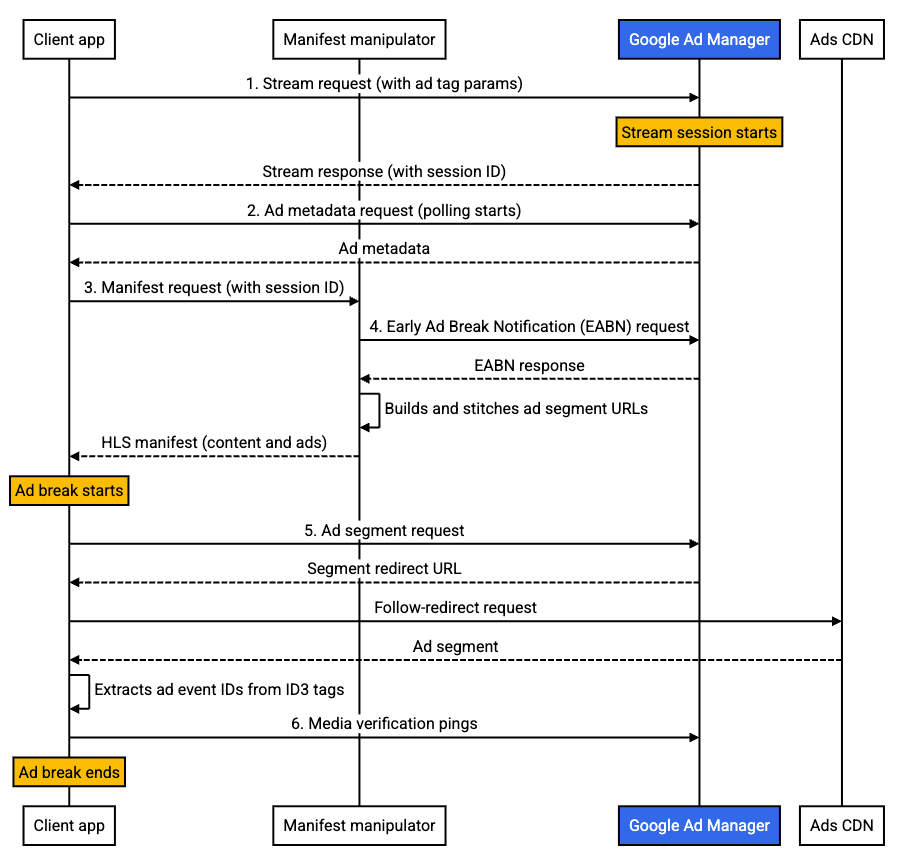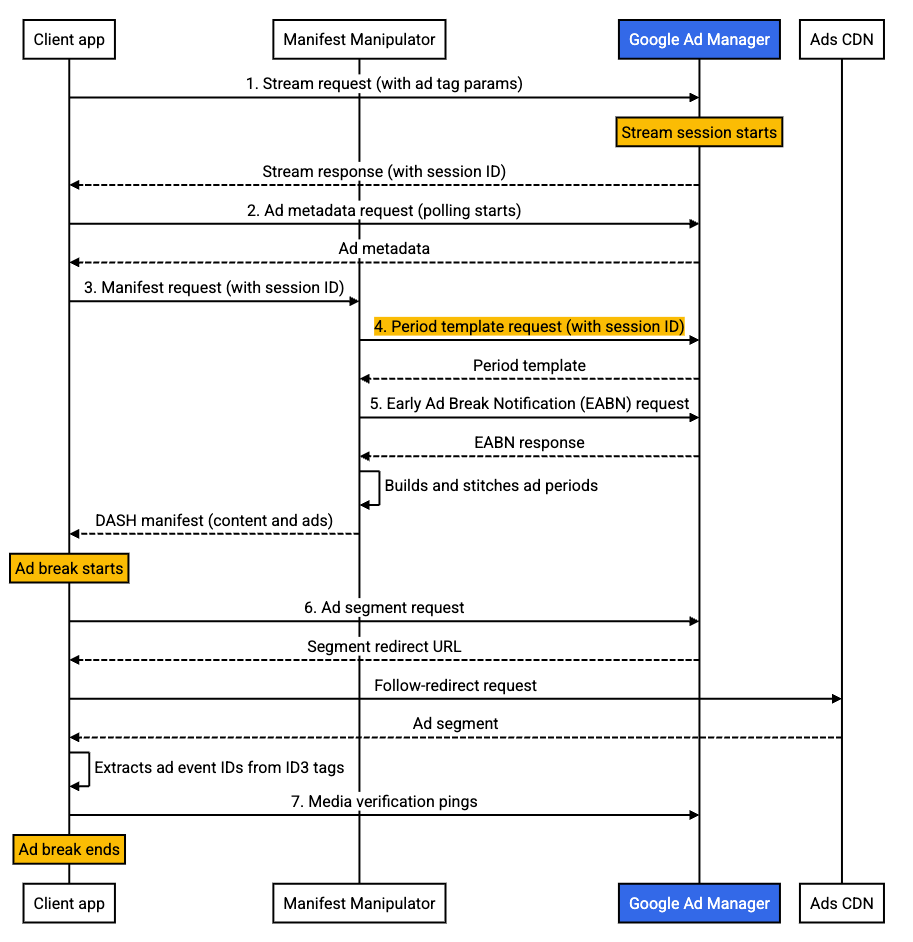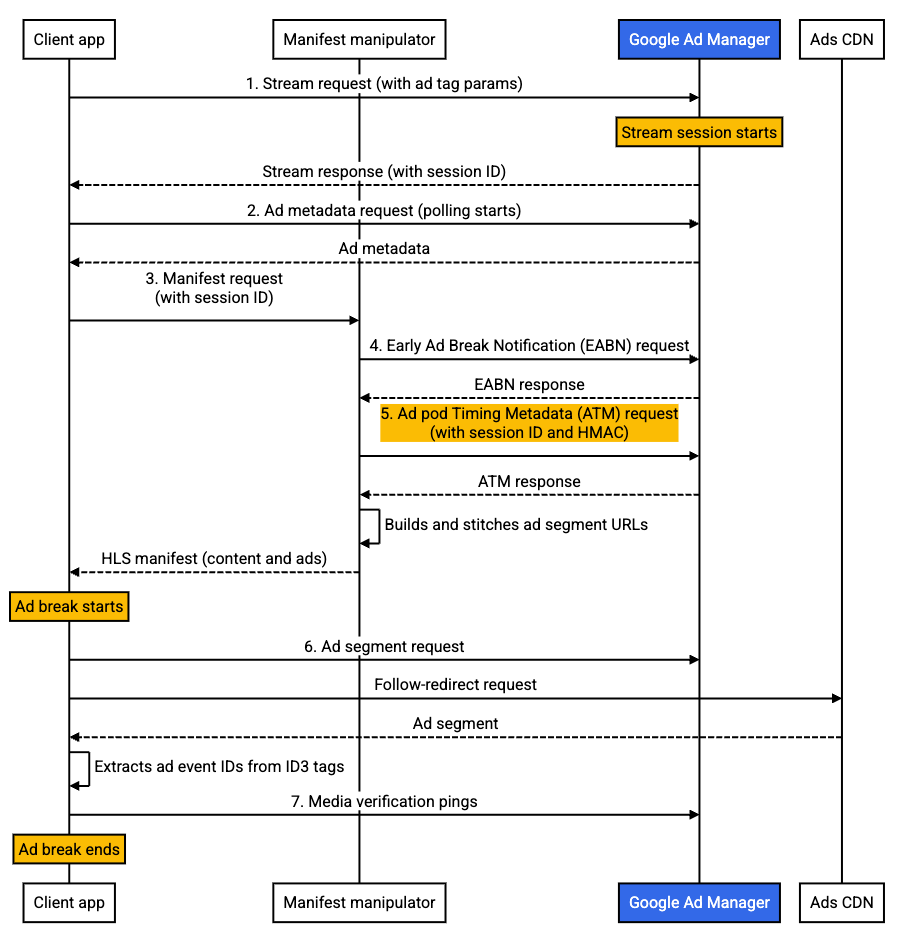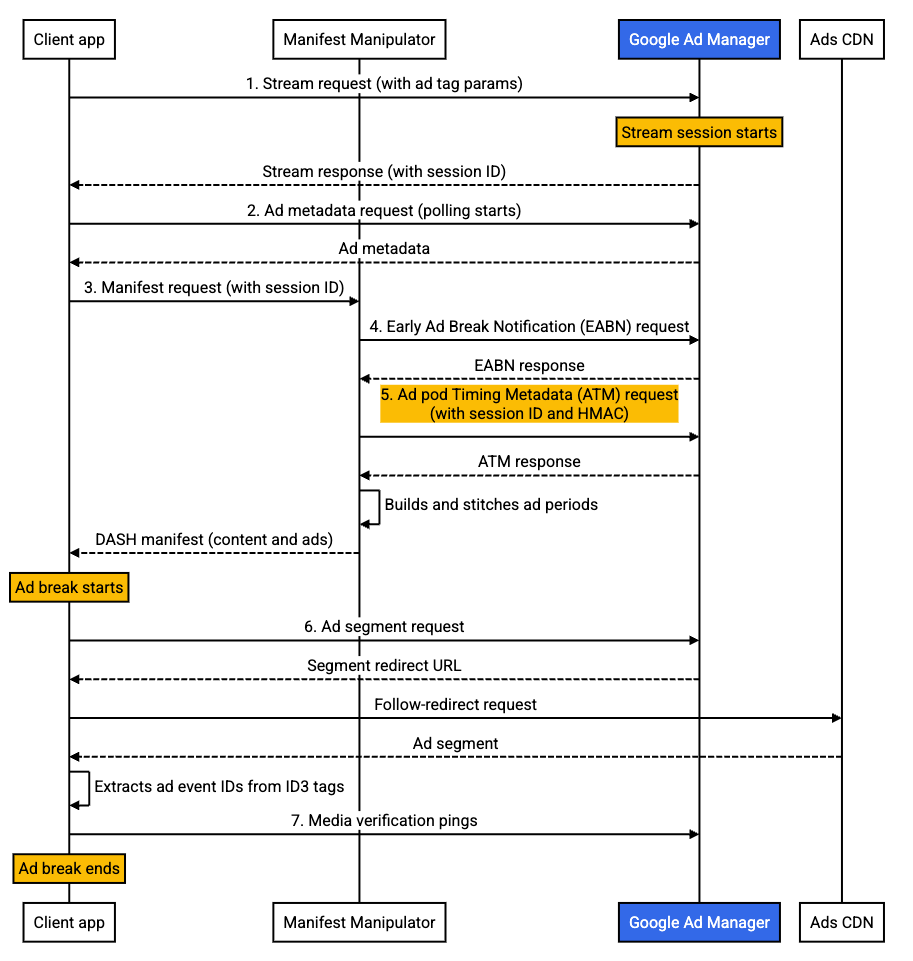برای پیادهسازی درج آگهی سمت سرور (SSAI) با پخش زنده HLS یا DASH، از Pod Serving API برای درخواست پادهای آگهی با نرخ بیت تطبیقی استفاده کنید. برای وضوح و نرخ بیت پشتیبانی شده، به قالبهای ویدیویی و صوتی و رمزگذاری مراجعه کنید.
این صفحه استفاده از Pod Serving API را برای پخش زنده پوشش می دهد.
پیش نیازها
قبل از ادامه، باید موارد زیر را داشته باشید:
یک رویداد پخش زنده را با نوع درج آگهی پویا (DAI) هدایت مجدد سرویس Pod پیکربندی کنید. یکی از گزینه های زیر را انتخاب کنید:
- یک پخش زنده برای DAI تنظیم کنید .
- یک کتابخانه کلاینت SOAP API را انتخاب کنید و متد
LiveStreamEventService.createLiveStreamEventsرا با یک شیLiveStreamEventو نوعdynamicAdInsertionTypeکه روی عددPOD_SERVING_REDIRECTتنظیم شده است، فراخوانی کنید. برای همه کتابخانه های سرویس گیرنده، کتابخانه های مشتری و کد نمونه را ببینید.
یک برنامه مشتری که در مرورگر وب، دستگاه تلفن همراه یا تلویزیون اجرا میشود تا جریان را بارگیری کند و رویدادها را مدیریت کند، مانند پخش، مکث، کلیک یا ضربه زدن.
یک دستکاری کننده مانیفست برای رسیدگی به درخواست های جریان از برنامه مشتری. مهم: برای سرویس مانیفست شما، جریان سرویس پیشرفته را توصیه میکنیم.
یک حساب Google Ad Manager با سرویس Pod DAI فعال است.
جریان سرویس اولیه
برای ارائه جریان خود، یک پروتکل پخش را انتخاب کنید و موارد زیر را انجام دهید:
HLS
برای ثبت یک جلسه، یک درخواست پخش جریانی از پخش کننده ویدیوی خود به Google Ad Manager ارائه دهید.
شروع نظرسنجی از ابرداده های تبلیغاتی برای رویدادهای تبلیغاتی آینده.
مانیفست پخش زنده را از دستکاری کننده مانیفست خود درخواست کنید.
اختیاری: یک اعلان وقفه تبلیغاتی زودهنگام به Google Ad Manager ارسال کنید . مهم: ما این مرحله را برای افزایش نرخ پر شدن توصیه می کنیم.
هنگامی که دستکاری کننده مانیفست شما یک نشانگر شکست آگهی را شناسایی می کند، URL های بخش تبلیغات را بسازید و آنها را به مانیفست بچسبانید.
- در طول یک وقفه تبلیغاتی، پخشکننده ویدیوی مشتری شما یک بخش آگهی را درخواست میکند و برای دانلود فایل بخش آگهی، URL تغییر مسیر بخش را دنبال میکند.
شناسههای رویداد تبلیغاتی را از برچسبهای ID3 استخراج کنید تا پینگهای تأیید رسانه را به Google بیابید و ارسال کنید.

داش
تمام مراحل را در تب HLS دنبال کنید.
یک بار الگوی دوره DASH را درخواست کنید و الگو را کش کنید. این رویکرد دورههایی را برای تمام وقفههای تبلیغاتی جلسه ایجاد میکند.

جریان سرویس پیشرفته
برای ارائه جریان خود، یک پروتکل پخش را انتخاب کنید:
HLS
برای ثبت یک جلسه، یک درخواست پخش جریانی از پخش کننده ویدیوی مشتری خود به Google Ad Manager ارائه دهید.
شروع نظرسنجی از ابرداده های تبلیغاتی برای رویدادهای تبلیغاتی آینده.
مانیفست پخش زنده را از دستکاری کننده مانیفست خود درخواست کنید.
اختیاری: برای افزایش نرخ پر شدن، یک اعلان وقفه تبلیغاتی زودهنگام به Google Ad Manager ارسال کنید .
یک درخواست ابرداده زمانبندی غلاف آگهی (ATM) به Google Ad Manager ارائه دهید.
برای ساخت URL های بخش تبلیغات، غلاف آگهی و زمان جدول دقیق را بازیابی کنید.
URL های بخش تبلیغات را به مانیفست بچسبانید.
وقتی دستکاری کننده مانیفست شما نشانگر شکست آگهی را تشخیص داد، URL های بخش تبلیغات را بسازید و URL ها را به مانیفست بچسبانید.
- در طول یک وقفه تبلیغاتی، پخشکننده ویدیوی مشتری شما یک بخش آگهی را درخواست میکند و برای دانلود فایل بخش آگهی، URL تغییر مسیر بخش را دنبال میکند.
شناسههای رویداد تبلیغاتی را از برچسبهای ID3 استخراج کنید تا پینگهای تأیید رسانه را به Google بیابید و ارسال کنید.

داش
تمام مراحل را در تب HLS دنبال کنید.
از پاسخهای فراداده زمانبندی آگهی (ATM) برای فیلدهای مورد نیاز اضافی برای ایجاد دورههای DASH استفاده کنید.

دستورالعمل گام به گام
برای جزئیات بیشتر در مورد نقاط پایانی API، به عنوان مثال دادههای درخواست و پاسخ، به برنامه پخشکننده ویدیوی Client برای پخش جریانی زنده و Manifest manipulator برای جریانهای زنده را ببینید.

